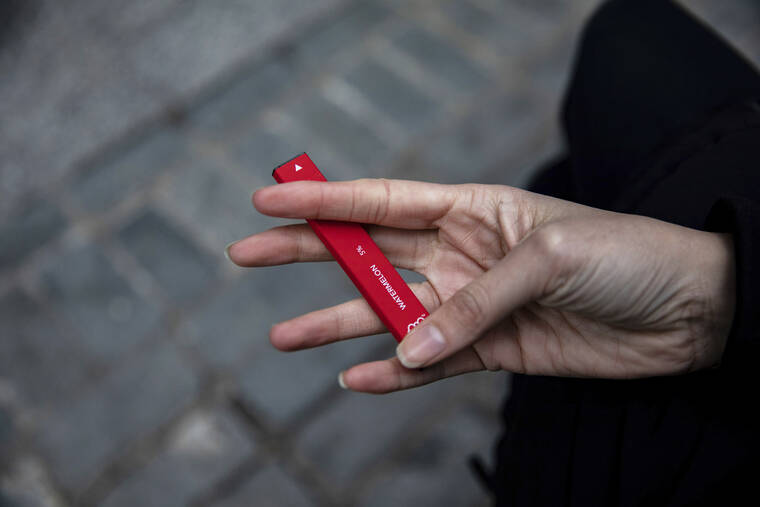
WASHINGTON >> U.S. regulators will soon begin cracking down on vaping companies using a now-closed loophole, including a line of fruit-flavored e-cigarettes that have become teenagers’ top choice.
Under a law taking effect today, the Food and Drug Administration can regulate e-cigarettes and similar products that use synthetic nicotine.
The action targets Puff Bar and several other vaping companies that recently switched their formulas to laboratory-made nicotine to skirt FDA oversight.
The change “allows FDA to protect the public health from the harms of tobacco products, regardless of the source of nicotine,” the agency said in a statement Wednesday. Companies must register with the FDA and submit their products for review within 30 days.
Puff Bar did not immediately respond to a request for comment today.
The FDA’s action does not automatically ban Puff Bar and similar products. Instead it brings them under the same regulatory scheme as older e-cigarettes that derived their nicotine from tobacco.
“The synthetic nicotine products do not necessarily just disappear on their own,” Robin Koval, chief executive of the Truth Initiative, an advocacy group that runs anti-tobacco ads. “The FDA will have to decide how they want to enforce the law and hopefully they will.”
The FDA has been reviewing applications for an array of vaping devices, formulas and flavors — rejecting more than 1 million, usually because of their potential appeal to youngsters. Anti-tobacco advocates hope the agency will quickly do the same for any applications submitted by Puff Bar and other manufacturers.
Nicotine, the chemical that makes smoking and vaping addictive, occurs naturally in tobacco plants.
The 2009 law that first gave the FDA oversight of cigarettes and related products only referred to tobacco-based nicotine. That left an opening for artificial nicotine, which is being used in e-cigarette liquids, nicotine pouches and other products.
Last month, Congress passed language clarifying that the FDA can regulate any form of nicotine, regardless of the source.
After appearing in 2019, Puff Bar has grown to become the most popular e-cigarette among teenagers, by far, sold in flavors like blueberry, strawberry banana and mango. Under FDA pressure, the company said it was halting sales in 2020, pulling its disposable vaping devices out of convenience stores, gas stations and vape shops.
Last February, the company announced a “fresh launch” of its colorful devices using synthetic nicotine. In marketing language, the company said its products “do not contain tobacco or anything derived from tobacco.” That put Puff Bar in a legal gray area, because federal, state and local restrictions nearly always apply to tobacco-based products, not nicotine itself.
Stanford researchers last year found synthetic nicotine products for sale via online platforms that prohibit tobacco sales, such as Amazon, eBay and Target. Under the new law, synthetic nicotine will be subject to the same federal age limit and sales restrictions as other tobacco products.
Using synthetic nicotine is not a new idea. Tobacco companies experimented with chemically derived nicotine as early as the 1960s, but deemed it too expensive for mass production. Manufacturing advances in recent years finally made it a viable alternative to tobacco-derived nicotine.
A large government survey last year showed Puff Bar had leapfrogged over better-known brands to become the top choice among high schoolers who vape. Juul — which is widely blamed for initially sparking the teen vaping trend — was the fourth most popular brand.
In 2020, the FDA restricted flavors in cartridge-based e-cigarettes like Juul to just menthol and tobacco, which are generally preferred by adults. But the flavor ban didn’t apply to disposable e-cigarettes like Puff Bar and other types of vaping devices.
Anti-tobacco groups worry that the FDA is always one or two steps behind whichever products are making inroads among kids.
“The lesson we can all take away from this is that when the FDA’s actions are incomplete and happen after the fact — which has often been the case with e-cigarettes — you will always be playing whack-a-mole and catch-up,” said Koval.
———
The Associated Press Health & Science Department receives support from the Howard Hughes Medical Institute’s Department of Science Education. The AP is solely responsible for all content.
Source: Star Ads




